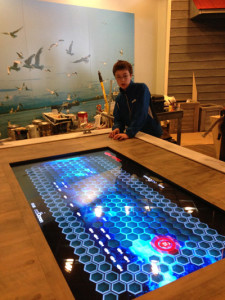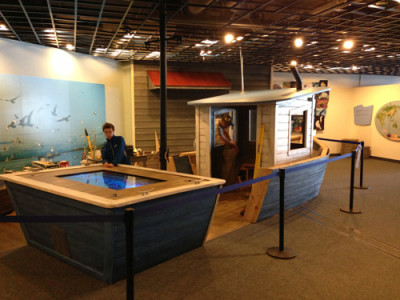This video game lets players 'go fish,' sustainably
by Kathleen McCoy |
(A version of this story appeared in the Anchorage Daily News on Sunday, June 2, 2013.)
When the Alaska Sealife Center celebrates World Oceans Day on June 8, visitors will have a chance to go fishing-virtually-using a new video game that showcases how a fishery can last for the long haul.
The game was originally developed and programmed by researchers at the University of Kiel in Germany. It promoted sustainable fishing by telling players who caught lots of fish that they were bad, and players who didn't catch many fish that they were good.
The Seward version has been reconfigured by two UAA researchers to more closely reflect fishing policies and attitudes in Alaska, where many successful fisheries have been managed for 50 years.

Like any video game, winners rack up the most points, or fish. But this game teachers players how not to exhaust a sustainable resource, and still win the game. It was developed at the University of Kiel in Germany, and reconfigured to match the policies and attitudes toward sustainable fishing that Alaskans share. (Photo by Jim Murphy/UAA)
Like any video game, players win by racking up the highest total score-by catching fish. The trick to the EcoOcean game is developing strategies that result in a high catch without jeopardizing the renewable resource.
The game invites four players to fish the ocean for three minutes. A track ball moves a player's fishing boat around an ocean layered with hexagonal cells. Click on a cell and you've fished there and upped your score.
There are nuances. Dark blue cells are loaded with fish; light blue cells have fewer fish and a cell with a fish skeleton on it has been overfished.
Alaska kids have already played a trial version of this game. About a year ago, UAA experimental economist Jim Murphy invited his son Ned, 12, and a half-dozen of his friends to try it out.
Most of the time, Murphy said, the kids hammered the fishery. They lost points by catching all the fish before the three minutes were even up. Or, they avoided a total resource crash, but caught fewer fish than is strategically possible.
Say a player earns 5,000 points, but post-game learns the highest scorer once earned 15,000 points. How did that player do it? Visual displays around the game will offer tips to increase a player's take.
Spoiler alert: The trick to maximizing your take is slowing down your fishing so the resource can continually renew itself. Another potential strategy is collaborating with teammates to divide up the ocean into sectors. That way, you can fish your area strategically without interference from others.
When you fish a cell, you catch half the fish in that cell and the adjacent cells. If the cells have the maximum 100 fish when you start, click once and only 50 will remain. Click again, only 25 remain. Keep clicking and you deplete them; fish skeletons pop up.
If you restrain yourself from maximizing the take in a cell, but instead move on after just one click, the cell will "re-grow" fish faster. A cell fished this way can continually renew itself and indefinitely provide fish.
Fisheries economist Gunnar Knapp is the other researcher behind adjusting this game for Alaska. He first saw the video game at a conference when the German researchers presented it.

The fishing boat at the top of the escalator in the Alaska SeaLife Center has always been an attraction for families with small children. This boat will still have the same features, but with the added attraction of a video game in the stern. (Photo by Jim Murphy/UAA)
He and Murphy had been developing simpler, low-tech versions of games that showed how players behaved when they competed for a resource. In one version, a big metal bowl filled with large beans sits in the middle of a table. Those are fish. Four players surround the bowl. They can earn money by "catching" the fish with measuring scoops. They can choose between big scoops that cost more or small scoops that cost less.
Videos show beans flying everywhere as players choose big scoops and rush to grab as many beans as they can. Lots of beans get wasted, ending up on the floor.
But tell players they are each allowed one-fourth of the total number of beans, and the manic behavior drops away. Videos show players methodically scooping beans with the small, cheap scoops, knowing they are guaranteed their shares. Few beans are wasted.
Knapp is fascinated by everything to do with fisheries, from biology to markets to human behavior. He pulls up a You Tube video documenting the 2010 herring sac roe fishery in Sitka. In it, fishing boats cluster and maneuver dangerously close. They burp black smoke as they wheel and turn tight circles in close quarters, even hull-ramming one other, in the quest for the maximum take during a narrow window of time.
"It's nuts," Knapp says. "Tell me, is there anything rational about this? It's just like the beans game."
Knapp and Murphy hope three messages resonate from the Alaska Sealife Center's EcoOcean game. Fishing is good; it creates jobs and provides food. But overfishing is bad, akin to killing the goose that laid the golden egg. And lastly, Alaska has a 50-year track record that demonstrates well-managed fisheries endure.
Both Murphy and Knapp mentioned the "tragedy of the commons," ecologist Garrett Hartin's 1968 theory that a common resource can be depleted by users acting in their own interest. Lucky for Alaskans, says Knapp, we have the only state constitution that requires fisheries and forests to be managed on a "sustainable yield" basis. Succeeding takes science and rules.
"Wherever you have a commons," Knapp says, "you'd better have cooperation or rules about how to use it." That's the lesson he hopes gamers will get.
For their part, the education staff at the Alaska SeaLife Center is excited to include the video game in their sustainable fishing exhibit.
"We are very grateful to those who have combined their efforts and resources to make this new boat exhibit possible," said Laurie Morrow, senior education manager. "This expansion of our existing sustainable seafood exhibit demonstrates that the choices we all make-as fishermen, residents, or consumers-are important elements of Alaska's tradition of managing fisheries sustainably."
 "This video game lets players 'go fish,' sustainably" is licensed under a Creative Commons Attribution-NonCommercial 4.0 International License.
"This video game lets players 'go fish,' sustainably" is licensed under a Creative Commons Attribution-NonCommercial 4.0 International License.









